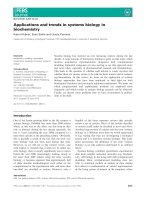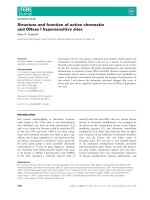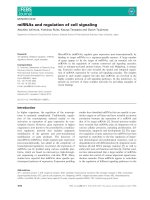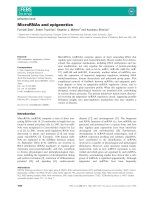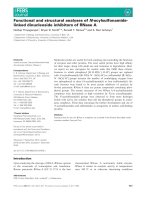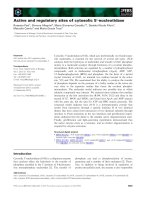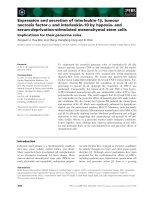Tài liệu Báo cáo khoa học: "DELIMITEDNESS AND TRAJECTORY-OF-MOTION EVENTS" pdf
Bạn đang xem bản rút gọn của tài liệu. Xem và tải ngay bản đầy đủ của tài liệu tại đây (872.54 KB, 11 trang )
DELIMITEDNESS AND TRAJECTORY-OF-MOTION EVENTS *
Michael White
Department of Computer and Information Science
University of Pennsylvania
Philadelphia, PA, USA
mwhit e@linc, cis. upenn, edu
Abstract
The first part of the paper develops a novel,
sortally-based approach to the problem of
aspectual composition. The account is ar-
gued to be superior on both empirical and
computational grounds to previous seman-
tic approaches relying on referential homo-
geneity tests. While the account is re-
stricted to manner-of-motion verbs, it does
cover their interaction with mass terms,
amount phrases, locative PPs, and dis-
tance, frequency, and temporal modifiers.
The second part of the paper describes an
implemented system based on the theoret-
ical treatment which determines whether
a specified sequence of events is or is not
possible under varying situationally sup-
plied constraints, given certain restrictive
and simplifying assumptions. Briefly, the
system extracts a set of constraint equa-
tions from the derived logical forms and
solves them according to a best-value met-
ric. Three particular limitations of the sys-
tem and possible ways of addressing them
are discussed in the conclusion.
1 Introduction
Ever since Verkuyl (1972) first observed that the as-
pectual class of a sentence depends not only on its
main verb (as in Vendler, 1967) but also on its verbal
*The author gratefully acknowledges the helpful com-
ments of Jeff Siskind, Mark Steedman, Matthew Stone,
and Christy Doran, as well as the support of DARPA
N00014-90-J-1863, ARO DAAL03-89-C-0031, NSF IRI
90-16592, Ben Franklin 91S.3078C-1.
arguments and modifiers, numerous researchers have
proposed accounts of this, the problem of ASPEC-
TUAL COMPOSITION. Of course, the ultimate aims
of these studies have never been to determine the
aspectual class of an expression per se clearly a
theory-internal notion but rather to predict the
outcomes of certain aspect-related syntactic and se-
mantic tests (cf. Dowty, 1979, Verkuyl, 1989). Like-
wise, the present paper focuses on these empirical
issues, in particular the compatibility of a given ex-
pression with
for-
and in-adverbials and the result-
ing existential and downward entailments. As an ex-
ample of this temporal adverbial test, consider (1)
below:
(1) (a) John drank beer * in ten minutes.
(*for}
(b) 3ohn drank a pint of beer in ten
minutes.
In example (1) we may observe that the appropriate
temporal adverbial is determined by the object of the
verb
drink
at least as long as we exclude from con-
sideration iterative, partitive, and other non-basic
readings (cf. Moens and Steedman, 1988).
Central to previous approaches to aspectual com-
position have been attempts to explain the puzzling
parallels between count noun phrases and telic sen-
tences on the one hand, which have inherently "de-
limited" extents, and mass nouns, bare plurals, and
atelic sentences on the other, which do not. In con-
nection with this intuitive notion of delimitedness, it
has often been observed that mass terms (e.g.
beer)
and bare plurals (e.g.
margaritas)
are similar to
atelic expressions (e.g.
John drink beer / margari-
tas),
insofar as they share the property of REFER-
ENTIAL HOMOGENEITY (reviewed below). This sets
412
them apart from count noun phrases (eg.
a pint of
beer)
and teiic expressions (e.g.
John drink a pint of
beer),
which do not generally do so.
Observations such as these led Dowty (1979), Hin-
richs (1985) and Krifka (1989, 1992) to incorporate
various tests for referential homogeneity into their
logical forms in order to account for the temporal
adverbial variations. I argue against this move here
by showing that it engenders a problem which I shall
call
THE ACCIDENTAL REFERENTIAL HOMOGENEITY
PROBLEM (defined below). As an alternative, I de-
velop in the first part of the paper a novel, sortally-
based approach to aspectual composition. The ac-
count is argued to be superior not only on empirical
grounds, insofar as it dissolves this particular prob-
lem, but also on computational grounds, insofar as it
justifies employing a feature-based approach. While
the account is restricted to manner-of-motion verbs
(e.g. run), it does cover their interaction with mass
terms, amount phrases, distance and locative modi-
fiers, and temporal adverbials.
In the second part of the paper, I describe an
implemented system based on the theoretical treat-
ment which determines whether a specified sequence
of events is or is not possible under varying sit-
uationally supplied constraints, given certain re-
strictive and simplifying assumptions. These as-
sumptions include requiring the sentences to spec-
ify trajectory-of-motion events (e.g. Guy jogging
from the inn to the bar) which are modeled as con-
tinuous constant rate changes of location in one
dimension. Briefly, the system extracts a set of
constraint equations from the derived logical forms
and solves them according to a best-value metric.
The system is implemented in
SCREAMER,
Siskind
and McAllester's (1993) portable, efficient version
of nondeterministic Common Lisp augmented with
a general-purpose constraint satisfaction package.
Three particular limitations of the system and pos-
sible ways of addressing them are discussed in the
conclusion.
2 The Accidental Referential
Homogeneity Problem
REFERENTIAL HOMOGENEITY is
the conjunction of
the properties of REFERENTIAL DIVISIVENESS and
REFERENTIAL CUMULATIVITY. An expression refers
divisively if whenever it applies to a given entity, it
also applies to all subentities of that entity, down
to a certain limit in size. For example, if there is a
material entity to which
beer
applies, then
beer
also
applies to all its (macroscopic) subparts; the same is
clearly not true of
a pint of beer.
Cumulativity works
in the other direction: an expression refers cumula-
tively if whenever it applies to two entities, it also
'applies to their collection. Here again, if we collect
two entities to which
beer
applies then we get some-
thing to which
beer
also applies; in contrast, if we
collect two entities to which
a pint of beer
applies,
we get an entity to which
two pints of beer
applies
instead. Similarly, we may observe that the atelic
expression
John drink beer
refers homogeneously to
situational entities (eventualities), unlike the
telic ex-
pression
John drink a pint of
beer.
With these properties in mind, THE ACCIDEN-
TAL
REFERENTIAL HOMOGENEITY PROBLEM
may be
stated as follows: some expressions which on intu-
itive and syntactic grounds should be in the
hetero-
geneous
class "happen" to refer homogeneously (cf.
Schubert and Pelletier 1989). This problem has been
noted in passing by Mittwoch (1982), Moens (1987),
and Krifka (1989), but to my knowledge has not been
systematically addressed by those focusing on the se-
mantics of aspect. The easiest examples to construct
involve lexical or quantificational vagueness, though
more insidious examples exist involving self-similar
objects. For instance, consider Mittwoch's
example
below:
(2) John wrote something in ten minutes which it
took me half an hour to translate.
The problem here is that the expression
John write
something
refers homogeneously, but nevertheless
combines with an in-adverbial if there is an event
of John writing something, then all the subevents
of that event (down to a certain limit in size) will
also be events of John writing something (Mbeit not
the same thing), and thus the expression refers divi-
sively; similar considerations show that it refers cu-
mulatively as well. To take another example, con-
sider the following sentence:
(3) John typed a sequence of characters in thirty
seconds (which it took me two minutes to write
by hand).
In (3) the problem is that subsequences of charac-
ters are also sequences of characters (albeit different
ones), and thus the expression
John type a
sequence
of characters
happens to refer homogeneously too.
Since the indicated expressions in (2) and (3) turn
out referentially homogeneous rather than heteroge-
neous, their compatibility with
in-adverbials
(and
not
for-adverbials)
is problematic for the theories of
Dowty, Hinrichs and Krifka. 1 Now, as an alternative
to the present approach, one might want to consider
basing an account of this problem on differing scope
possibilities for the expressions which "accidentally"
and "truly" refer homogeneously that is, to some-
how allow for different subquantities of beer but not
different subsequences of characters. A serious prob-
lem for any such approach, however, is the existence
of readings where the temporal adverbial has wide
scope, as in (4):
1Showing this in detail is beyond the scope
of the
present
paper. For a
more
detailed exposition of this
problem as it relates to Ktifl~'s theory,
see White
(1993).
413
(4) Amazingly, John replied to every new email
message in under two hours.
The availability of such wide scope readings does
not seem compatible with the idea of requiring the
quantified phrase to outscope the temporal adver-
bial, which would seem to be necessary in order to
(always) correctly predict the appropriate temporal
adverbial by means of a referential homogeneity test.
Beyond the empirical problems engendered by ref-
erential homogeneity tests, there appear to be sig-
nificant computational ones as well. From the gen-
eration standpoint, it seems quite unreasonable to
test whether any or all subevents of an event to be
described happen to meet the same description be-
fore choosing a temporal adverbial to convey dura-
tion. Likewise, from the standpoint of interpreta-
tion, if one is to make use of aspectual information
in processing successive sentences in discourse (as in
the theories of Hinrichs, 1986, Moens and Steedman,
1988, and Lascarides and Asher, 1991, for example),
there is equally little time for performing such tests. 2
3 Theory
3.1 Ontology
Various authors (including Link, 1983, Bach, 1986,
Krifka, 1989, Eberle, 1990) have proposed model-
theoretic treatments in which a parallel ontological
distinction is made between substances and things,
processes and events, etc. A similarly parallel dis-
tinction is employed here, but in a rather different
way: unlike the above treatments, the present ac-
count models substances, processes, and other such
entities as abstract kinds whose realizations vary in
amount. As such, the approach developed here may
be seen as building upon the work of Carlson (1977)
and his successors; it also represents one way to fur-
ther formalize the intuitions found in Moens and
Steedman (1988) and Jackendoff (1991).
Following Schubert and Pelletier (1987), the
present account distinguishes individuals from kinds,
but not from stages or quantities. Extending their
ontology, the same distinction is assumed to hold
not only in the domain of materials but also in the
domain of eventualities, and derivatively in the do-
mains of space and time as well. This extension sets
the stage for taking a sortal approach to the seman-
tics of aspect, in contrast to previous model-theoretic
accounts.
3.2 Semantics
Let us assume a many-sorted higher-order logic with
model structures consisting of the following elements,
2A similar point was suggested by Manfred Krifka
(p.c.).
Entity
• Material
- Substance
- Thing
• Eventuality
- Process
- Event
• Space
- Trajectory
• Time
• Amount
- Quantity
- Distance
- Duration
• Number
Figure 1: The (Abbreviated) Sort Hierarchy
plus an interpretation function:
• a set of entities: E
• sorts: Material, Eventuality, Kind,
• binary relations: p, comp, E_, r, amt,
To structure the set of entities E, we require permis-
sible models to satisfy various axioms on the binary
relations.
Roughly following Eberle (1990) and Jackend-
off (1991), we assume postulates enforcing the (non-
exhaustive) sort hierarchy shown in Figure 1. We
also assume that certain sorts cut across the hier-
archy, in particular the disjoint sorts Kind and In-
dividual. These sorts partition the sorts Material,
Eventuality, Space and Time. Some of the resultant
sorts are named in Figure 1; these equivalences are
shown below:
• Kinds
Substance = Kind f3 Material
Process = Kind fl Non-State
• Individuals
Thing = Individual fl Material
Event = Individual fl Non-State
Following Schubert and Pelletier, we map pred-
icates to kinds using the operator p. To map
kinds to their realizations, we employ a relation
comp(osed of) inspired by Jackendoff's (1991) con-
ceptual function of the same name. As this relation
is central to the present account, its sortal require-
ments are shown below:
414
(5) Vxy. comp(z)(y) * Kind(x) A Individual(y)
(6) For all S in {Material, Eventuality, }:
Vxy.
comp(z)(y) -* S(z)
A
S(y)
In the spirit of Krifka (1989) and Eberle (1990),
we also employ a partial order ff (part of) on the
sort Individual, as well as total orderings ~ and <
on the sorts Amount and Number, respectively. F]
nally, we employ spatio-temporal trace functions r
mapping from Eventuality to Space and to Time, as
well as a function am(oun)t mapping from Individual
to Amount.
We relate the preceding binary relations as follows.
First, formal kinds and their realizations are required
to satisfy the following axiom: 3
(7) VPz.
comp(p(P))(z) ~ P(z)
Second, we require the spatio-temporal trace func-
tions r to be homomorphisms preserving the part-of
relation, as shown below:
(8) Vele2 • el_e2 ~ v(el)__.v(e2)
Third, we also require the spatio-temporal trace
functions to preserve the composed-of relation, at
least when they map processes to kind-level entities,
as shown in (9); in the case of the temporal trace
function
rt,
this requirement is strengthened to hold
generally, as shown in (10):
(9) Veal. comp(e)(el) ^ Kind(r(e))
* comp(r(e))(r(el ))
(10) Veel. comp(e)(ea) * comp(rt(e))(rt(el))
Fourth, as a correlate of referential divisiveness, we
assume that the set of individuals composed of a
given kind is closed under the part-of relation; that
is, whenever an individual y= is composed of a certain
kind z, then all subparts Yl of y~ are also composed
of z, as shown in (11). 4
(11)
Vxyly2.
comp(z)(y2)
A
ylff_y2 -*
¢omp(z)(yl)
Finally, we require the function amt and unit mea-
sures such as minutes' to satisfy various fairly ob-
vious postulates concerning the preservation of the
orderings __, _ and _<.
3.3
Syntax
The rudimentary categorial grammar given in Fig-
ure 2 suffices to derive all of the logical forms in the
next section. Note that lexemes such as
slime
are
paired with syntactic categories such as n and se-
mantic functions such as slime ~ (where the category
vp abbreviates s \ np). Three e-rules are also em-
ployed, one for introducing p in a bare np, one for
SNote
that not
all kinds need involve #; presumably,
conventional
kinds such as Coke or Heineken are named
directly.
4Because
of the notorious
MINIMAL PARTS PROBLEM
(i.e., how little beer is still beer?), this postulate is
not
quite
correct as stated; amending it would require adding
a
condition that
yl be "large enough ~ for the kind z.
lifting a vp to apply to a generalized quantifier, 5 and
one for adding an existential quantifier to the sen-
tence radical (ignoring tense and mood).
3.4 Aspeetual Composition
Manner-of-motion verbs such as run, wa&, etc. are
interesting insofar as the telicity of the expressions
in which they are used is dependent upon both the
subject NP and an optional trajectory-specifying PP:
(12) John ran along the river for 20 minutes.
(13) John ran to the bridge in 20 minutes.
(14) Slime oozed into the urn for 20 minutes.
(15) Two liters of slime oozed into the urn in 20
minutes.
Let us assume that such verbs take material entities
as arguments and describe eventualites (either events
or processes). To capture their aspectual behavior,
we stipulate the following preliminary postulate:
For all A in {run', ooze', } :
(16)
we.
[Individual(e)
Individual(rs(e)) A Individual(z)]
Meaning postulate (16) states that if A(z) holds of
an eventuality e, where A ranges over run e, ooze ~,
etc., then e is an event (an individual eventuality) if
and only if its spatial trace rs(e) is an individual tra-
jectory and x is a thing (i.e., an individual material).
If we assume that the expression
to the bridge
only
describes individual trajectories, then postulate (16)
forces
John run to the bridge
to describe an event.
In contrast, if we assume that the expression
along
the river
is not restricted in this way, then
John run
along the river
may describe a process as well. To
capture this formally, the following meaning postu-
late is needed:
(17)
Vzp.
to'(x)(p) * Individual(p)
Given the categories listed in Figure 2, the expres-
sions
John run along the river
and
John run
to the
bridge
receive the following translations:
(18) Ae. run'(j)(e ) A along'(the'(river'))(rs(e))
(19) Ae.
run'(j)(e)
A to'(the'(bridge'))(rs(e))
From meaning postulates (16) and (17), it follows
that the latter expression must describe events; with
no analogous meaning postulate for
along,
the former
expression is free to describe processes as well.
Before continuing, it is worth explaining why pos-
tulate (17) is a reasonable one. Recall that a given
process stands in the composed-of relation to mul-
tiple events. If these events differ in their spatial
extents, then the spatial trace of the process can-
not sensibly be an individual-level entity, assuming
SThis
rule is a simplified version of a more general
rule which
introduces an existential quantifier over the
eventuality
variable.
415
John
ten
liters
of
slime
the
run
e
miles
to
for
in
minutes
e
:= np
:= num
:= gq [ pp-of\ num
:= pp-of/np
: ~ n
:
np/
n
:= np / n
: s\np
:=
s \gq/vp
: vp\vp\num
:= vp\vp/tm
:= vp\vp/tm
:= vp\vp/tm
:= tm \num
:-" U/8
: j
: 10
: ~nmP. B~. comp(m)(x) ^ amt(~) = liters'(n) ^ P(~)
: Az. z
: slime'
: g
: the'
:
run'
: APQe.Q(Az.P(:r)Ce))
: AnPxe.
P(z)(e) ^ amt(rs(e)) = miles'(n)
: AyPze.
P(z)(e) ^ to'(y)(rs(e))
: AdPxel. Be. P(z)(e) h comp(e)(el) ^ amt(rt(el)) = d
: ,~dPze.
P(z)(e) A amt(rt(e)) _ d
: minutes'
: AP.Be.P(e)
Figure 2: Rudimentary Syntax
unique amounts (distances) for individual trajecto-
ries; instead, it should be a kind-level trajectory,
standing in the composed-of relation to the various
individual trajectories corresponding to these multi-
ple events as per postulate (9). It is in this sense
that the spatial trace of a process may not be "delim-
ited" in extent. Of course, this does not mean that
the spatial trace of a process cannot be bounded in
any absolute sense; in the case of
along the river,
for
example, no resultant trajectory is allowed to con-
tinue (very far) past the river's end. l~eturning now
to to
the river,
we may note that this expression de-
scribes the end point of a trajectory; as such it is
naturally restricted to describing individual trajec-
tories, which always have defined endpoints.
Next we turn to
slime
and
two liters of slime.
Given the categories listed in Figure 2, the expres-
sions
Slime ooze into the urn
and
Two liters of slime
ooze into the urn
receive the following translations:
(20)),e. ooze'(u(slime'))(e) ^
into'(the'(urn'))(rs(e))
,Xe. Bz. comp(g(slime'))(z) ^
(21) amt(x) = liters'(2) ^ ooze'(z)(e) ^
into'(the'(urn'))(n(e))
Now,
if we assume a sortal
meaning
postulate
for
into
analogous to that of
to,
then it follows from the
sortal requirements on p and comp that (20) can only
describe processes, whereas (21) can only describe
events.
At this point we are ready to consider the temporal
adverbials. Not surprisingly, the relation comp is
crucial to the present account of the for- vs.
in-
adverbial test data, as can be seen from comparing
their semantics: whereas for-adverbials measure out
a process using comp and a given amount of time,
in-adverbials simply require that an event take place
within a given amount of time.
Let us first consider how the machinery developed
so far can be used to account for examples (14) and
(15), augmented below:
(22) Slime oozed into the urn
{for}
* in twenty minutes.
(23) Two liters of slime oozed into the urn
{*for t
in twenty minutes.
The respective translations of the two possibilities in
(23) follow:
3zeel. comp(p(slime'))(z) A
amt(x) = liters'(2) ^ ooze'(x)(e) ^
(24) into'(the'(urn'))(rs(e)) ^
comp(e)(el) ^ amt(rt(el)) = minutes'(20)
Bze. comp(p(slime'))(z) ^
amt(z) = liters'(2) ^ ooze'(x)(e) ^
(25) into'(the'(urn'))(rs(e)) ^
amt(r,(e)) -< minutes'(20)
Since the entity e in (24) is required to be an event,
comp(e)(el) turns out undefined, s making (24) se-
mantically anomalous. In contrast, lacking comp,
the translation in (25) is unproblematic. Simi-
lar reasoning shows that (22) can only be compat-
ible with for-adverbials, assuming durations (i.e.,
amounts of temporal traces) are not defined for pro-
cesses. Furthermore, these same considerations lead
to the correct predictions in examples (12) and (13)
as well. T Finally, without further ado the theory
makes the correct predictions in (26) below, as dis-
tances (amounts of spatial traces) are only defined
for events:
sI-Iere I am assuming for expository purposes that the
interpretation of a function is undefined if any of its ar-
gument terms are not of the appropriate sort, or are un-
denned themselves.
ZNote, however, that the theory as it stands cannot
rule out
? John ran along the river in £0 minutes,
which
comes out meaning the same thing as
John ran some
distance along the river in ~0 minutes.
416
* for ~ twenty
(26) John ran four miles in j "
minutes.
Up until this point we have relied (in part) on the
stipulated postulate (16) to capture the temporal ad-
verbial data. We consider now how we may derive
this
postulate from more basic assumptions, begin-
ning with the following one:
For all A in {run', ooze' } :
Wee~. A(x)(e) ^ comp(e)(e~)
(27) [3~. A(=l)(el) ^ comp(r.(e))(~.(ed)]
V [:Ix1. A(xl)(el) A comp(z)(xl)]
Postulate (27) is meant to capture in a novel way
the intuition that a A process e must be "measured
out" either by its trajectory Ts(e) or by its material
argument x (cf. Krifka, 1989, Dowty, 1991, Tenny,
1992, Verkuyl and Zwarts, 1992). It does so by re-
quiring that all individual events el composed of e be
A events with either an individual trajectory %(el)
composed of %(e) or an individual material argument
x~ composed of x (or possibly both). From (27) fol-
lows the only-if (~ ) part of (16), as follows: if both
x and rs(e) are individual-level entities, then neither
of the alternatives in the. consequent of (27) can be
true, since the composed-of relation is not defined for
individual-level entities; therefore, by way of contra-
diction, e cannot be a process (at least if we assume
all kind-level entities are in the domain of comp).
To make the if( +) part of (16) follow too, we may
employ the following postulate:
For all A in {run', ooze', } :
(28) We. A(x)(e) ^ Individual(e)
R(amt(rt(e) ) )(amtO'Je) ) )(amt(x) )
Postulate (28) relates the duration of a A event
to the length of its trajectory and the quantity of
its material argument by some unspecified relation
R (which might limit speeds to acceptable ranges,
for example). Since amounts are only defined for
individual-level entities, this forces the trajectory
and material argument of a A event to be individual-
level as well.
3.5 Referential Homogeneity Revisited
While the property of referential homogeneity does
not play a part in capturing the for- vs. in-adverbial
test data in the present approach, it is nevertheless
necessary to account for certain desired inferences.
In particular, we shall need a version of referential
divisiveness in order to make the first but not the
second inference below a valid one:
(29) John ran along the river for five minutes.
John ran along the river for four minutes.
(30)
-, John ran to the bridge in five minutes.
John ran to the bridge in four minutes.
Given the translation of John ran to the bridge in n
minutes
in (31) below, it is easy enough to see why
(30) is not a valid inference: all that is needed is a
model in which there is an event of John running
to the bridge that takes more than four minutes but
takes place
within five minutes.
(31) 3e. run'(j)(e) A to'(the'(bridge'))(~',(e)) ^
amt(rt(e)) _
minuteg(n)
Turning now to (29), consider the translations
below:
(32) 3ee2. run'(j)(e) A along'(the'(river'))(r.(e))
A comp(e)(e2) A amt(rt(e)) = minutes'(5)
(33) 3eel . run'(j)(e) A along'(the'(river'))(rs(e))
A comp(e)(et) A amt(l"t(e)) = minutes'(4)
Note here that the variables have been (equivalently)
renamed to indicate which we shall take to be the
same and which different: that is, we shall take
e2
and el to be two events of different durations com-
posed of the same process e. To get (29) to follow in
this way, we need the following two postulates:
For all A in {run', ooze', } :
(34) Vze2dl . A(z)(e2) A dl _ amt(rt(e2)) ,
3el . elEe2 A amt(rt(el)) = dl
For all r in {along', to', } :
(35) Vze. r(x)(rs(e)) A comp(e)(el) ,
r(x)(r,(el))
Postulate (34) states that if a A event e2 has du-
ration amt(rt(e2)), then for all lesser durations dl,
e2 has subevents el of that duration; postulate (35)
states that r trajectory predicates are preserved by
the composed-of relation. From postulate (34) it fol-
lows that the running event e2 of duration five min-
utes must have a subevent el of duration four min-
utes, which we know by (11) to be composed of the
same process e; finally, postulate (35) ensures that el
is also located along the river, thus validating (29).
In addition to accounting for the downward en-
tailments above, the machinery developed so far also
accounts for existential entailments such as the one
in (36), assuming the translation of the consequent
given in (37):
Slime oozed into the urn for ten minutes.
(36) Some amount of slime oozed into the urn
in ten minutes.
3zme. comp(/~(slime'))(z) A Amount(m) A
(37) amt(x) = m ^ ooze'(x)(e) ^
into'(the'(urn'))(r.(e)) ^
amt(rt(e)) -< minutes'(10)
The inference (36) follows by postulates (27) and
(35). Since Some amount of slime ooze
into the
urn turns out to be referentially homogeneous, (36)
concomitantly shows how the present approach dis-
solves
THE ACCIDENTAL REFERENTIAL
HOMOGENE-
ITY PROBLEM.
417
3.6
Repetitions
So far we have been careful to exclude from consid-
eration the iterative readings that for-adverbials can
induce (cf. Moens and Steedman, 1988, Jackend-
off, 1991). Here we consider some extensions to the
approach developed above which permit these to be
captured as well.
Let us begin by adding retried sets to the do-
main of individuals, along the lines of Link (1983)
or Krifka (1989). We do so by partitioning the sort
Individual using disjoint sorts Atom and Non-Atom
and introducing a new relation __.i (individual part
of) isomorphic to the subset relation over the power
set of the atoms, minus the empty set (to avoid con-
fusion, we might rename the other part of relation
E_q, for quantity part of). We also add a cardinality
function [ • ] mapping individuals to numbers, and
an operator plur(al) mapping predicates over atoms
to predicates over non-atoms. Naturally enough, we
require the operator plur to satisfy the following pos-
tulate, where __.~i is equal to ___i with its domain re-
stricted to the atoms:
(38) VPzlz2. plur(P)(z2) A zl__.aiz2
-"*
P(Zl)
Given this additional machinery, we may account
for the iterative readings induced by for-adverbials
by simply positing a lexical ambiguity between the
reading for for given in Figure 2 and the one below:
(39)
for: ~dPxel. 3e. t~(plur(P(z))) = e ^
comp(e)(el) ^ amt(rt(e)) = d
Note that in reading (39), the process e measured out
by the for-adverbial is not the one described by P(z),
but rather the one equal to/~(plur(P(z))), which has
as its realizations collections of P(z) events of vary-
ing cardinalities; note also that the sortal require-
ments on plur and comp ensure that the two readings
off or-adverbials are in complementary distribution,
insofar as only one can ever be defined for a given
eventuality predicate p.8
Finally, we may observe that these same extensions
can be used to give a natural account of frequency
adverbials such as twice or n times:
(40) twice: APze. plur(P(x))(e) ^ l e 1= 2
4 Application
In this section we turn to an implemented system
based on the above theoretical treatment which de-
termines whether a specified sequence of events is or
is not possible under varying situationally supplied
constraints. The domain is limited to trajectory-
of-motion events specified by the verbs run, jog,
sit is worth noting
that as an alternative to posit-
ing a lexical ambiguity, one could just as easily invoke
a coercion operator on an event predicate P(z) map-
ping it to the process predicate he. #(plur(P(x))) = e,
which would bring the present treatment more in line
with Moens and Steedman (1988) and Jackendoff (1991).
plod, and walk; the locative prepositions to, towards,
from, away from, along, eastwards, westwards, and
to
and back; various landmarks; the distance adver-
bials n miles; the frequency adverbials twice and n
times; and finally the temporal adverbials for and
in. Trajectory-of-motion events are modeled as con-
tinuous constant rate changes of location in one di-
mension of the TRAJECTOR relative to one or more
LANDMARKS (following Regier 1992 in his use of Lan-
gacker's 1987 terminology).
Briefly, the system takes a set of landmark loca-
tions (which are assumed to remain constant) and an
input string from which it derives all possible logical
forms for the given sentences; it then extracts a set of
constraint equations from the derived logical forms
and solves them according to a best-value metric. If
a solution is found, it is displayed as a space-time
diagram as shown in Figure 3. Note that distances
are in miles, durations are in minutes, and the range
of rates associated with the verbs are appropriate for
a serious athlete.
The best-value metric currently employed is prox-
imity to the median rate for the given manner of
motion, summed across successive events. Accord-
ing to this metric, an event such as Guy running to
the bar takes a default amount of time according to
the distance and the median rate; however, an event
of Guy running to the bar in n minutes may take
less time if this duration is less than the default
at least up to the point where the specified duration
requires exceeding the given maximum running rate,
thus making the constraint equations unsatisfiable.
Likewise, an event of Guy running along the river
(towards the bar, say) for n minutes will yield a de-
fault distance according to the amount of time and
the median rate; this distance may vary according to
more demanding distance requirements imposed by
succeeding sentences, again up to a certain point.
The times of successive repetitive events are
summed, so that scope differences between frequency
and temporal adverbials may be adequately treated;
that is, the system correctly determines when one
but not the other of Guy jogged to the care and back
in ten minutes twice and Guy twice in ten minutes
is possible. The summing of the durations of succes-
sive events also allows the system to determine an
appropriate number of iterations for Guy jogged
to
the cafe and back for 30 minutes. 9
The system is implemented in SCREAMER, Siskind
and McAllester's (1993) portable, efficient version
of nondeterministic Common Lisp augmented with
a general-purpose constraint satisfaction package.
Taking advantage of SCREAMER'S compatibility with
the COMMON LISP OBJECT SYSTEM, constraints are
specified in a declarative, hierarchical fashion. As
an example, Figure 4 shows how variables associ-
9Note that the system cannot find a solution for
Guy
ran to the bar ]or 30 minutes, since there is no provision
for adding unspecified events (such as leaving the bar).
418
Guy's Journey
Time
120.00 -
110.00 -
100.00 -
90.00 -
80.00 -
70.00 -
60.00-
50.00 -
40.00-
30.00 -
20.00 -
10.00 t ~
0.00
I
0.00
I I
5.00 10.00
Guy
- mouth
bridge
m
care
- museum
bar
inn
-dam
Location
Figure 3: Program output for the following input string: "Guy walked eastwards along the river for 40
minutes. Then he jogged from the cafe to the museum. Next he ran to the bar and back three times in 20
minutes. Finally he plodded to the inn." Note that
for 20 minutes
could have been used instead of
three
times in 20 minutes.
419
(defclaes trajectory-event ()
;;; etc
(del~aited :initformnil)
;;; etc
(defmethod initialize-instance :after
((e trajectory-event) treat inits)
;;; etc
(assert! (=v dt (-v tl tO)))
(assert! (=v d (*v r dr)))))
(defclaeerun-event (trajectory-event)
())
(defmethod
initialize-instance :after
((e run-event) ~reet
lairs)
(declare (ignore inits))
(let ((r (slot-value • 'rate)))
(assert! (<=v r (/ I 4.5)))
(assert! (>=v r (/ i 6.5)))))
Figure 4: Declarative, hierarchical constraint speci-
fication in SCREAMER.
ated with the trajectory-of-motion class of events
are constrained according to the formula distance =
rate x time; it also shows how a further constraint
on rates is associated with the running specialization
of this class.
Because the domain is so simple, adequate con-
straints on trajectories are trivial to specify. Some-
what more imaginatively, processes are modeled by
their constrained but unsolved-for realizations; they
are distinguished from them solely (and efficiently!)
by the value of the feature
delimited, as
justified
by the sortal approach advocated in the last section.
Likewise, kind- and individual-level trajectories are
distinguished by the same feature, in such a way as
to maintain postulate (16). Lest the reader miss the
point for its simplicity, it is worth emphasizing (re-
calling Figure 3) that this feature is crucial for de-
termining whether single instances or repetitions are
involved in sentences such as Guy walked eastwards
along the river/or ~0 minutes and Guy ran to the
bridge and back for ~0 minutes.
5
Conclusion
In this paper I have presented a novel, sortally-based
approach to the problem of aspectual composition
which I have argued to be superior on both em-
pirical and computational grounds to previous ap-
proaches relying on referential homogeneity tests. I
have also described an implemented system based on
the theoretical treatment which determines whether
a specified sequence of trajectory-of-motion events is
or is not possible under varying situationally speci-
fied constraints.
Beyond its obvious shortcomings, there are three
specific limitations to the system worth mentioning.
First, the range of discourses is limited to narrative
sequences, which greatly simplifies the necessary rea-
soning (el. Hwang and Schubert, 1991, Lascarides
and Asher, 1991, Hobbs et. el. 1993). Second, the
present approach does not lend itself well to flexibly
accommodating new information. Third, in the case
where a specified sequence of events turns out not
to be possible, the constraint satisfaction approach
does not provide any mechanism for explaining why
this happens to be so. In order to address these prob-
lems, in future work I intend to investigate to what
extent the present approach can be meshed with the
Interpretation as Abduction approach advocated by
Hobbs et. al., which appears to be well suited to
these issues.
References
[Bach, 1986] Emmon Bach. The algebra of events.
Linguistics and Philosophy, 1986.
[Carlson, 1977] Greg Carlson. A unified analysis of
the English bare plural. Linguistics and Philoso-
phy, 1:413-457, 1977.
[Dowty, 1979] David R. Dowty. Word Meaning and
Montague Grammar. Reidel, 1979.
[Dowty, 1991] David Dowty. Thematic proto-roles
and argument selection. Language, 67(3):547-615,
1991.
[Eberle, 1990] Kurt Eberle. Eventualities in natu-
ral language understanding systems. In Sorts and
Types in Artificial Intelligence. Springer Verlag,
1990.
[Habel, 1990] Christopher Habel. Propositional and
depictorial representations of spatial knowledge:
The case of path-concepts. In Natural Language
and Logic. Springer Verlag, 1990. Lecture Notes
in Artificial Intelligence.
[Hays, 1989] Ellen M. Hays. On defining motion
verbs and spatial relations. Technical Report 61,
Universit~it des Saarlandes, 1989. SFB 314 (VI-
TRA).
[Herskovits, 1986] Annette Herskovits. Language
and Spatial Cognition. Cambridge University
Press, 1986.
[Hinrichs, 1985] Erhard Hinriehs. A Compositional
Semantics for Aktionsarten and NP Reference in
English. PhD thesis, The Ohio State University,
1985.
[Hinrichs, 1986] Erhard Itinrichs. Temporal
anaphora in discourses of English. Linguistics and
Philosophy, 9(1), 1986.
420
[Hobbs
et al.,
1988] Jerry Hobbs, Mark Stickel, Paul
Martin, and Douglas Edwards. Interpretation as
abduction. In
Proceedings of ACL,
1988.
[Hobbs
et al.,
1993] Jerry Hobbs, Mark Stickel,
Douglas Appelt, and Paul Martin. Interpretation
as abduction, 1993. To appear in Artificial Intel-
ligence Journal.
[Hwang and Schubert, 1991] Chung Hee Hwang and
Lenhart K. Schubert. Tense trees as the "fine
structure" of discourse. In
Working Notes of the
AAAI Fall Symposium on Discourse Structure in
Natural Language Understanding and Generation,
Asilomar,
CA,
November 1991.
[Jackendoff and Landau, 1991] Ray Jaekendoff and
Barbara Landau. Spatial language and spatial cog-
nition.
LEA,
1991.
[Jaekendoff, 1991] Ray Jackendoff. Parts and
boundaries.
Cognition,
41:9-45, 1991.
[Krifka, 1989] Manfred Krifka. Nominal reference,
temporal constitution and quantification in event
semantics. In R. Bartsch, J. van Benthem, and
P. van Emde Boas, editors,
Semantics and Con-
textual Expressions.
Dordrecht, 1989.
[Krifka, 1992] Manfred Krifka. Thematic relations
as links between nominal reference and temporal
constitution. In Ivan A. Sag and Anna Szabolcsi,
editors,
Lexical Matters.
CSLI, 1992.
[Langacker, 1987] Ronald Langacker.
Foundations
of Cognitive Grammar I: Theoretical Prerequisites.
Stanford University Press, 1987.
[Lascarides and Asher, 1991] Alex Lascarides and
Nicholas Asher. Discourse relations and defensi-
ble knowledge. In
Proceedings of the PPth Annual
Meeting of the Association for Computational Lin-
guistics,
1991.
[Link, 1983] G6dehard Link. The logical analy-
sis of plurals and mass terms. In R. Bauerle,
C. Schwarze, and A. yon Steehow, editors,
Mean-
ing, Use, and Interpretation of Language.
de
Gruyter, 1983.
[Link, 1987] G/Sdehard Link. Algebraic semantics of
event structures. In J. Groenendijk, M. Stokhof,
and F. Veltman, editors,
Proceedings of the Sixth
Amsterdam Colloquium,
1987.
[Mayer, 1989] Roll Mayer. Coherence and motion.
Linguistics,
pages 437-485, 1989.
[Mittwoch, 1982] Anita Mittwoch. On the difference
between
eating
and
eating something:
Activities
versus accomplishments.
Linguistic Inquiry,
1982.
[Moens and Steedman, 1988] Marc
Moens and Mark Steedman. Temporal ontology
and temporal reference.
Computational Linguis-
tics,
June 1988.
[Moens, 1987] Marc Moens.
Tense, Aspect and Tem-
poral Reference.
PhD thesis, University of Edin-
burgh, 1987.
[Pelletier and Schubert, 1989] Francis Jeffry Pel-
letier and Lenhart K. Schubert. Mass expressions.
In D. Gabbay and F. Guenthner, editors,
Hand-
book of Philosophical Logic,
chapter IV.4, pages
327-407. D. Reidel Publishing Company, 1989.
[Regier, 1992] Terrance Philip Regier.
The Acqui-
sition of Lezical Semantics for Spatial Terms: A
Connectionist Model of Perceptual Categorization.
PhD thesis, University of California at Berkeley,
1992.
[Schubert and Pelletier, 1987] Lenhart K. Schubert
and Francis Jeffry Pelletier. Problems in the rep-
resentation of the logical form of generics, plurals,
and mass nouns. In
New Directions in Semantics,
pages 385-451. Academic Press, 1987.
[Siskind and McAllester, 1993a]
Jeffrey Mark Siskind and David Allen MeAllester.
Nondeterministic
LISP
as a substrate for constraint
logic programming. Technical Report IRCS-93-03,
University of Pennsylvania, 1993.
[Siskind and McAllester, 1993b]
Jeffrey Mark Siskind and David Alien McAllester.
SCREAMER:
A portable efficient implementation
of nondeterministic COMMON LISP.
To
appear in
AAAI-93, 1993.
[Tenny, 1992] Carol Tenny. The aspectual interface
hypothesis. In Ivan A. Sag and Anna Szabolcsi,
editors,
Lexieal Matters.
CSLI, 1992.
[Vendler, 1967] Zeno Vendler.
Linguistics in Philos-
ophy.
Cornell University Press, 1967.
[Verkuyl and Zwarts, 1992] Henk Verkuyl and Joost
Zwarts. Time and space in conceptual and logical
semantics: the notion of path.
Linguistics,
pages
483-511, 1992.
J
[Verkuyl, 1972] H. J. Verkuyl.
On the Compositional
Nature of the Aspects.
Reidel, 1972.
[Verkuyl, 1989] H. J. Verkuyl. Aspectual classes and
aspectual composition.
Linguistics and Philoso-
phy,
12(1), 1989.
[White, 1993] Michael White. On pasta makers and
delimitedness. In
Proceedings of the Penn Review
of Linguistics,
volume 17, 1993.
[Zwarts and Verkuyl, 1991] Joost Zwarts and Henk
Verkuyl. An algebra of conceptual structure; an
investigation into Jackendoff's conceptual seman-
tics. Forthcoming, 1991.
421
